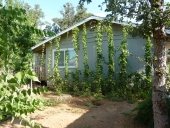
 2
2




 1
1




Nunyara Wholesale Forestry Nursery owner Mike Jubow recently received his highly-anticipated diesel tree seeds from Brazil.
Mr Jubow had spent three years trying to buy the seeds, which grow into trees that can be tapped for fuel.
The 20kg shipment of seeds was finally released from Australian quarantine in early December.
...
Mr Jubow first heard about the diesel trees at a forestry convention several years ago and the idea of growing bio-fuel from an unlimited source sparked his interest.
After three years of persistence, he found a farmer in Brazil whose family had been growing the trees for 100 years who was willing to sell them.
Pecan Media: food forestry and forest garden ebooks
Now available: The Native Persimmon (centennial edition)
 2
2




Company specializing in production and sales of seeds native and exotic , forest plug , fastest way to produce seedlings, and the innovative acorn live creative and fun way to restore nature.
The Florestando stresses the value of the environment, working for the preservation and conservation of biodiversity. We are dedicated to collecting native seeds for seedlings that meets the permanent preservation areas and legal reserves. We work with low-impact techniques, redemption of shares of . flora and multiplication of new forests with high diversity and genetic variability.
Pecan Media: food forestry and forest garden ebooks
Now available: The Native Persimmon (centennial edition)












'Theoretically this level of creeping Orwellian dynamics should ramp up our awareness, but what happens instead is that each alert becomes less and less effective because we're incredibly stupid.' - Jerry Holkins
 1
1












 1
1








![Filename: copaifera-langsdorffii-380x760.jpg
Description: [Thumbnail for copaifera-langsdorffii-380x760.jpg]](/t/47538/a/73586/copaifera-langsdorffii-380x760.jpg)
Pecan Media: food forestry and forest garden ebooks
Now available: The Native Persimmon (centennial edition)
 1
1
















Dale Hodgins wrote:I've seen many things grown well outside of their Zone, that will produce some leaf. But that doesn't mean we're going to get a useful crop. People grow bananas and olives here on Vancouver Island. Or at least they say they do. What I've seen are banana and Olive plants that give a bunch of leaf but failed to produce any useful amount of fruit. A few, keep them in green houses and do manage to get a taste. But the input costs are far too high.
I wonder if some people are headed down the same road with this tree, in hope of getting the same production that occurs in its native range.
Pecan Media: food forestry and forest garden ebooks
Now available: The Native Persimmon (centennial edition)

|
I will suppress my every urge. But not this shameless plug:
The new permaculture playing cards kickstarter is now live!
https://www.kickstarter.com/projects/paulwheaton/garden-cards
|






